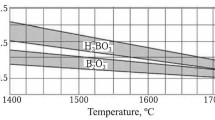Conclusions
-
1.
Sintering of bronze filters is accompanied by complex interactions of the mold material (steel 12Kh18N9T) with the filter material (bronze Br0F10-1), the most important of which are oxidation of the surface of the mold and interdiffusion of the components.
-
2.
Oxidation of steel 12Kh18N9T under these sintering conditions is accompanied by oxidation of chromium, which leads to impoverishment of the surface in chromium and the development of a zone of internal oxidation.
-
3.
The diffusional penetration of the filter components — copper, tin, and phosphorus — into the mold in the process of sintering is accompanied by alloying of these elements with the basic mold material (iron) and leads to further reduction of its oxidation resistance. Especially harmful is simultaneous alloying with copper and phosphorus.
Similar content being viewed by others
Literature cited
O. Kubaschewski and B. Hopkins, Oxidation of Metals [Russian translation], Metallurgiya, Moscow (1968), p. 17.
Additional information
Translated from Metallovedenie i Termicheskaya Obrabotka Metallov, No. 12, pp. 47–49, December, 1982.
Rights and permissions
About this article
Cite this article
Vasil'eva, E.V., Trekina, M.I., Artemenko, N.S. et al. Failure of stainless steels in contact with tin-phosphorus bronze. Met Sci Heat Treat 24, 859–862 (1982). https://doi.org/10.1007/BF00774870
Issue Date:
DOI: https://doi.org/10.1007/BF00774870




